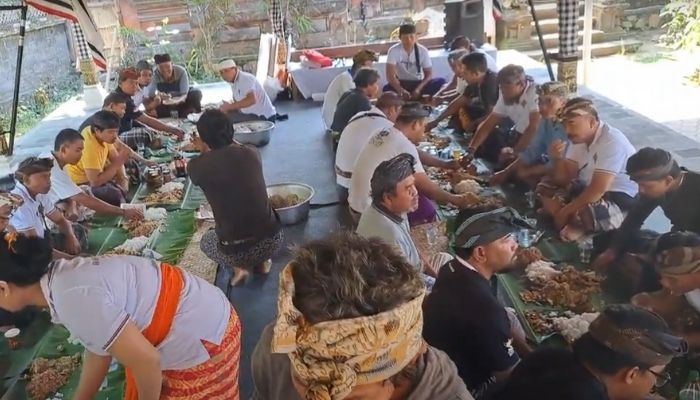If you’re in Bali and hear about a communal eating event from one big tray, that’s called megibung. This tradition is not just about enjoying food, but also about togetherness, equality, and a local culture that is still strongly preserved to this day. Megibung can be considered one of the most exciting and meaningful expressions of Balinese tradition.
What is Megibung?
Megibung is the habit of eating together from one large tray. This tradition is often carried out during traditional ceremonies, religious events, or social gatherings in the village. For example, during a temple ceremony (odalan), a cremation ceremony, or a banjar meeting.
What makes it unique is that everyone sits at the same level in a circle and eats together directly from the tray—no spoons, no plates, all using their hands. What’s more fun is the warm and friendly atmosphere, far from anything formal.
The Origins of the Megibung Tradition
This tradition is said to have started during the time of the King of Karangasem. At that time, megibung was used to strengthen the bond between leaders and the people, or among fellow soldiers. Everyone sat on the ground, ate from the same container, so that no one would feel superior or inferior.
From there, megibung spread into a general tradition that is now commonly found in many villages across Bali.
The Atmosphere of Megibung: Warm and Fun
When megibung takes place, the atmosphere is usually very warm and friendly. Everyone chats after eating, shares stories, and jokes around. Sometimes there’s also coffee or tea enjoyed together afterward. Even if you’ve just met, the mood quickly becomes relaxed because you’ve already “shared food” together.
Megibung becomes a moment of togetherness, as well as an opportunity to strengthen the bond between community members. Young people can learn traditional customs from the elders, and all generations come together as one.
The Meaning and Values Behind Megibung
Behind the tray of rice and shared dishes, there are deep values that have been passed down through generations:
-
Spirit of Equality
Everyone sits at the same level, eating from the same place. This symbolizes that among fellow human beings, we are all equal. -
Togetherness Without Boundaries
Eating together brings hearts closer. A sense of family arises naturally. -
Gratitude and Mutual Respect
Eating from one tray teaches us to appreciate both food and others more. We become more mindful, less greedy, and more willing to share. -
A Medium for Learning Culture
Young people can directly see and experience how traditional values are passed on through everyday activities.
Megibung Today
Even though times have become modern, megibung still exists and is increasingly preserved. Many family events, village meetings, even campus or community activities adopt this concept. Some restaurants are even beginning to offer megibung packages for tourists who want to try an authentic experience.
Moreover, this tradition is also becoming widely known through social media. Many people document megibung moments through videos, stories, or vlogs—so it’s not just a meal, but also educational and inspirational content.
Conclusion
Megibung is how Balinese people show that eating is not just a need, but also a form of love and togetherness. Through one big shared tray, warm bonds and a strong sense of kinship are created.
If you ever get the chance to join a megibung, don’t miss it. Feel the warmth of Balinese culture through a plate of rice and a bit of sambal matah—because sometimes, the simplest things are the most memorable.












